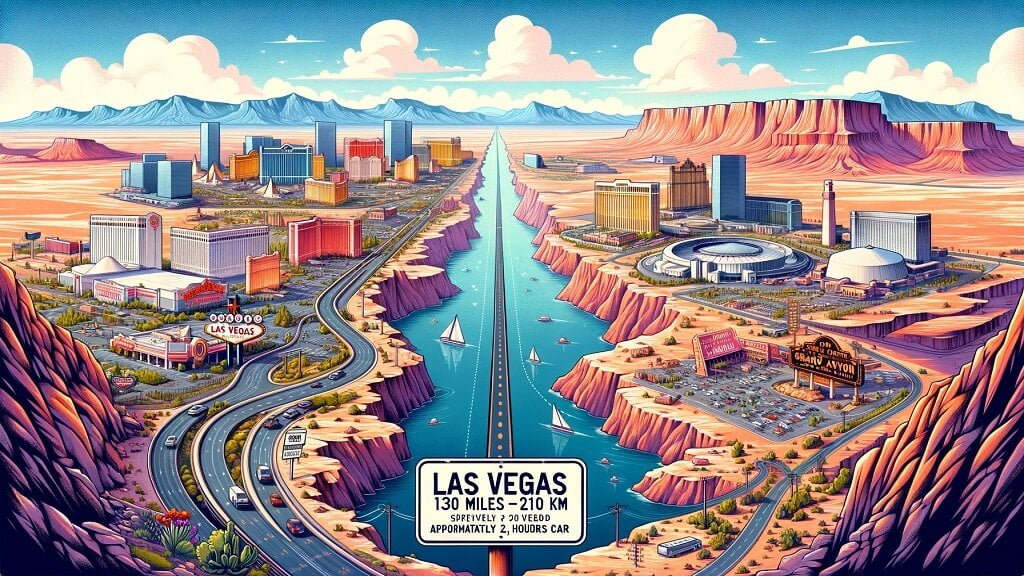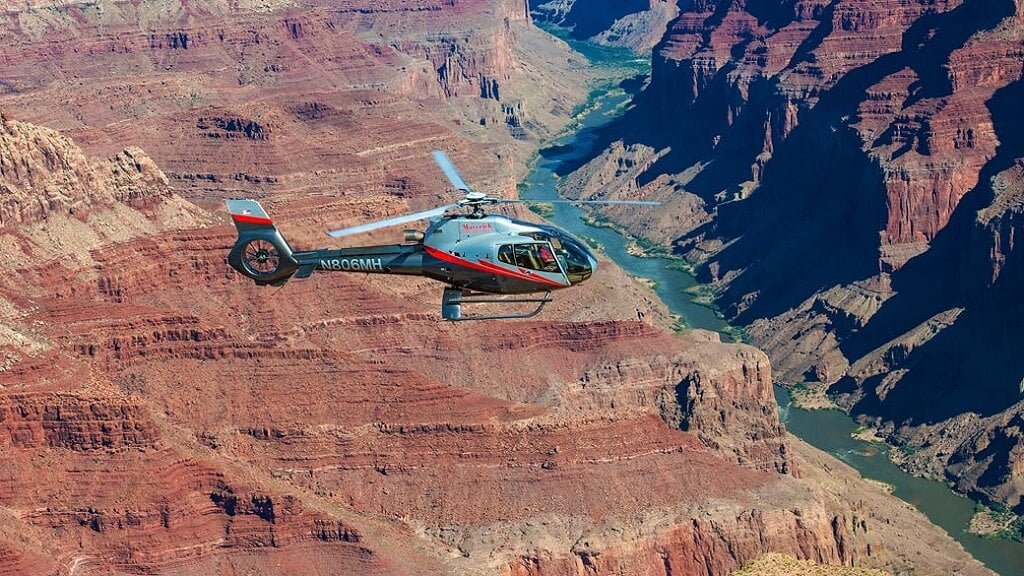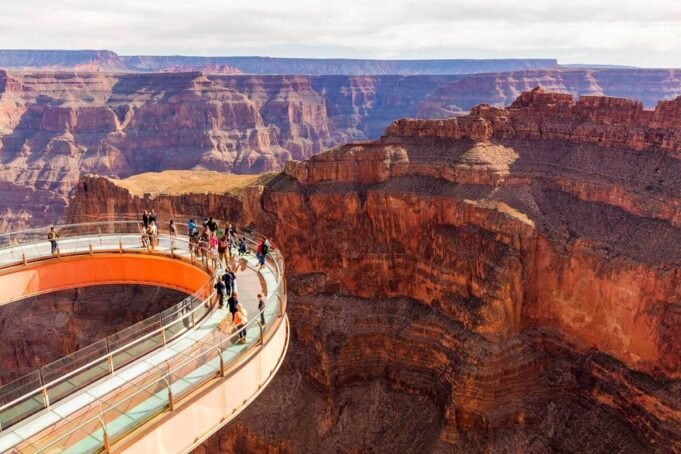While you’re in Las Vegas, don’t miss the chance to explore the Grand Canyon! It’s nearer than you might expect and even more enchanting than you could envision. So How Far is the Grand Canyon from Las Vegas?
Las Vegas, a glittering gem nestled in the Mojave Desert, is famed for its vibrant nightlife centered around 24-hour casinos and other entertainment options. Its High Roller Ferris wheel, Bellagio fountains, and neon-lit Strip are iconic landmarks that draw millions each year. On the other hand, the Grand Canyon, one of the world’s seven natural wonders, is a sprawling, awe-inspiring chasm carved by the Colorado River, showcasing millions of years of geological history through its layered bands of red rock.
The journey from Las Vegas to the Grand Canyon is a bucket-list adventure for many. These two destinations, though starkly different in character—one a man-made spectacle, the other a natural marvel—are frequently paired together in itineraries by travelers seeking to experience the best of American culture and landscape.
Geographic Overview
The Grand Canyon is situated in the state of Arizona, southeast of Las Vegas, Nevada. These neighboring states are divided by the Colorado River and the Hoover Dam, a testament to human engineering. The Grand Canyon itself stretches 277 miles long, up to 18 miles wide, and attains a depth of over a mile, showcasing vast geological expanses.
Routes to the Grand Canyon
The route from Las Vegas to the Grand Canyon largely follows Interstate 40 and Arizona State Route 64. A popular detour includes a stop at the historic Route 66 town of Seligman, Arizona, where travelers can enjoy a taste of classic Americana. Other points of interest include the Hoover Dam, Lake Mead, and the Hualapai Indian Reservation, where the Grand Canyon Skywalk is located.
The journey itself is part of the experience, with the shifting landscapes offering a visual treat—from desert valleys to mountain vistas—and a clear sense of the vastness and diversity of the American Southwest. Each route and mode of transport offers a unique perspective of this vast landscape, inviting travelers to choose their own adventure.
Read More: Best Time To Visit Arizona National Parks
How Far is the Grand Canyon from Las Vegas
The Grand Canyon is primarily divided into three rims: the South, North, and West. The South Rim is the most developed and accessible year-round, offering a variety of viewpoints, historical sites, and amenities. The North Rim, which is higher in elevation, offers a quieter experience and is typically open from mid-May to mid-October due to heavy snowfall in the winter. The West Rim, located on the Hualapai Indian Reservation, is home to the famous Skywalk, a glass bridge extending out over the canyon.
Distance to the Grand Canyon West Rim from Las Vegas

Situated approximately 130 miles (210 kilometers) from Las Vegas, the journey to the Grand Canyon West, or the West Rim, can be completed in around 2 to 2.5 hours by car. Travelers should be well-prepared as the route offers limited services.
The Grand Canyon stretches over 277 miles (445 kilometers) in length, making the West Rim the most convenient section for visitors from Las Vegas to access. With proper planning, a day trip to the West Rim from Las Vegas is perfectly feasible.
Distance to the Grand Canyon South Rim from Las Vegas
While the South Rim is the most frequented section of the Grand Canyon, it is also the farthest from Las Vegas, at 275 miles (440 kilometers) away. The drive typically takes about 4 to 4.5 hours.
The journey to the South Rim is more challenging compared to the West Rim but is entirely on well-maintained highways. The splendors of the South Rim make the trip worthwhile.
For those traveling to the South Rim, it is advisable to consider an overnight stay, with Williams, AZ being a prime location. This is especially true for those wishing to explore additional sights en route to the canyon.
Regarding whether to start from Las Vegas or Phoenix for a trip to the South or North Rim, the latter two are more easily reached from Phoenix.
Distance to the Grand Canyon North from Rim Las Vegas
The North Rim presents the most challenging drive among the canyon’s sections. Located about 260 miles (420 kilometers) from Las Vegas, the drive takes roughly 4 to 4.5 hours.
The North Rim is slightly closer than the South Rim but is less accessible, especially since the road to it closes seasonally due to snow from late autumn to the onset of spring.
Read Also: Do You Need a Passport to Go to Cancun
Distance by Mode of Transport
By Car
The drive from Las Vegas to the Grand Canyon primarily leads to the South Rim, the most visited section of the canyon. This journey spans approximately 280 miles and takes around 4-5 hours, depending on traffic and the exact starting point in Las Vegas.
Bus Tours
For those who prefer not to drive, bus tours are a popular option. They offer a relaxed journey with knowledgeable guides and typically last about 14-15 hours round trip. These tours often include several stops at viewpoints and provide a hassle-free way to experience the Grand Canyon’s majesty.
Air Tours

For a quicker and more thrilling view of the canyon, helicopter and plane tours are available. These can vary in duration from a quick 45-minute aerial tour to a full-day excursion that includes landing at the canyon.
Planning Your Trip
Best Times of Year to Visit
The best time to visit the Grand Canyon is during the spring (April to June) and fall (September to November) when the weather is mild, and the crowds are thinner. Summer months tend to be very hot and crowded, while winter can bring snow and limited accessibility, especially to the North Rim.
Tips on Avoiding Crowds
To avoid crowds, consider visiting on a weekday or arriving early in the morning or later in the afternoon. Also, exploring less popular overlooks and trails can provide a more solitary experience.
Recommendations for Overnight Stays
For those wishing to extend their visit, the South Rim offers a variety of lodges and campgrounds. Near the West Rim, overnight options include cabins on the Hualapai reservation and hotels in nearby cities like Kingman or Boulder City.
Also Read: Things To Do In French Lick Indiana
Tour Options
Self-guided Tours vs. Guided Tour Packages
Self-guided tours allow for flexibility and personal pacing, ideal for explorers who prefer mapping their own routes and schedules. Guided tours, on the other hand, offer structured itineraries with the added benefit of expert knowledge from guides, often including transportation, meals, and sometimes even accommodation.
Comparison of Tour Companies
Several tour companies operate out of Las Vegas, offering a range of experiences from luxury coaches to off-road adventures. Some notable names include Pink Jeep Tours, known for their small group sizes and off-road treks, and Grand Canyon Coaches, offering comfortable bus trips with panoramic windows for optimal sightseeing. When selecting a tour, consider factors like group size, included amenities, and the duration of the tour to find the best fit for your Grand Canyon adventure.
Things to Consider
Weather Conditions and Clothing Recommendations
The weather in the Grand Canyon can be unpredictable, varying greatly between the rims due to differences in elevation. The South Rim is cooler than the West Rim, and the North Rim is the coolest due to its higher elevation. Summer temperatures at the bottom of the canyon can be extreme. Lightweight, breathable clothing is recommended for the summer months, while layers are essential for the cooler spring and autumn, and warm insulated gear for the snowy winter months. Regardless of the season, hats, sunscreen, and sturdy shoes are a must for protection against the strong sun and rugged terrain.
Safety Tips for Traveling in the Desert
Desert conditions can present unique challenges. Carry plenty of water—at least one gallon per person per day—to avoid dehydration. Be aware of weather forecasts, as flash flooding can occur. Stay on designated paths, and be mindful of wildlife. Lastly, ensure your vehicle is desert-ready, with ample fuel, a spare tire, and an emergency kit.
Importance of Booking in Advance
Popular activities and accommodations at the Grand Canyon can sell out quickly, especially during peak seasons. To secure your preferred lodging and tours, book several months in advance. This is particularly important for camping permits, coveted viewpoints, and guided tours.
Also Read: Holiday destinations in Modesto, California
Conclusion
How Far is the Grand Canyon from Las Vegas? The journey from Las Vegas to the Grand Canyon is not just a trip from one destination to another; it’s an exploration of contrast, from the man-made spectacle to the natural grandeur. The key to a memorable visit lies in preparation—understanding the demands of the desert, booking ahead, and planning your route to include the myriad of attractions along the way. Whether you’re gazing out from the Skywalk or hiking a rim trail, the Grand Canyon’s majesty is a profound counterpoint to Las Vegas’s dazzling lights. Together, they offer an experience that is quintessentially American and one that should not be missed.
Frequently Asked Questions (FAQs)
Here are some example frequently asked questions (FAQs) for the “How far is the Grand Canyon from Las Vegas?”:
How far is the Grand Canyon from Las Vegas?
The distance to the Grand Canyon from Las Vegas varies depending on the rim. The West Rim is approximately 130 miles away, taking about 2 to 2.5 hours to drive. The South Rim is about 275 miles away, with a drive time of around 4 to 4.5 hours. The North Rim is roughly 260 miles away, also about a 4 to 4.5-hour drive.
Can you do a day trip to the Grand Canyon from Las Vegas?
Yes, a day trip to the West Rim of the Grand Canyon is quite popular and easily doable given its proximity to Las Vegas.
Which Grand Canyon Rim is Closest?
The West Rim is the closest to Las Vegas, approximately a 2.5-hour drive away. This proximity makes it an ideal day trip destination for those based in Las Vegas. The West Rim’s highlight, the Grand Canyon Skywalk, and the ability to experience the canyon’s depth directly beneath one’s feet make it a unique and popular choice.
What is the best time of year to visit the Grand Canyon?
The ideal time to visit the Grand Canyon is during the spring (April to June) and fall (September to November) months when the weather is temperate and the crowds are fewer. These seasons boast comfortable temperatures for hiking and offer clear views of the canyon’s vastness. Summer brings intense heat, especially on the canyon floor, and larger crowds, while winter can lead to road closures at the North Rim due to snow. Visiting during the shoulder seasons also provides the added benefit of experiencing the Grand Canyon with its changing colors and wildlife, making for a pleasant and picturesque trip.
Are there guided tours from Las Vegas to the Grand Canyon?
Yes, there are many guided tour options available from Las Vegas to the Grand Canyon, including bus, jeep, and helicopter tours.
Can you stay at the Grand Canyon overnight?
Yes, you can stay at the Grand Canyon overnight. There are lodging options available on both the South and North Rims, ranging from hotels and historic lodges to rustic cabins and campgrounds. The South Rim is open year-round and offers a variety of accommodations within the park itself, such as the famous El Tovar Hotel. The North Rim has fewer facilities and is typically open from mid-May to mid-October. For those seeking an immersive experience, backcountry camping is also available with a permit. It’s essential to book well in advance, especially during peak seasons, as these accommodations fill up quickly due to the park’s popularity.
What route should I take from Las Vegas to the Grand Canyon?
To the West Rim, take US-93 South to Pierce Ferry Road to Diamond Bar Road. For the South Rim, take US-93 South to I-40 East to Highway 64. To the North Rim, take I-15 North to UT-9 East to US-89 South to Highway 67.
















[…] the end of this guide, you’ll clearly understand how far Reno is from Las Vegas and the best transportation options available. Whether you’re traveling for business or […]
[…] you visit the Grand Canyon in Northern Arizona, prepare for a journey that demands both time and vigor. The initial glimpse of […]
Comments are closed.